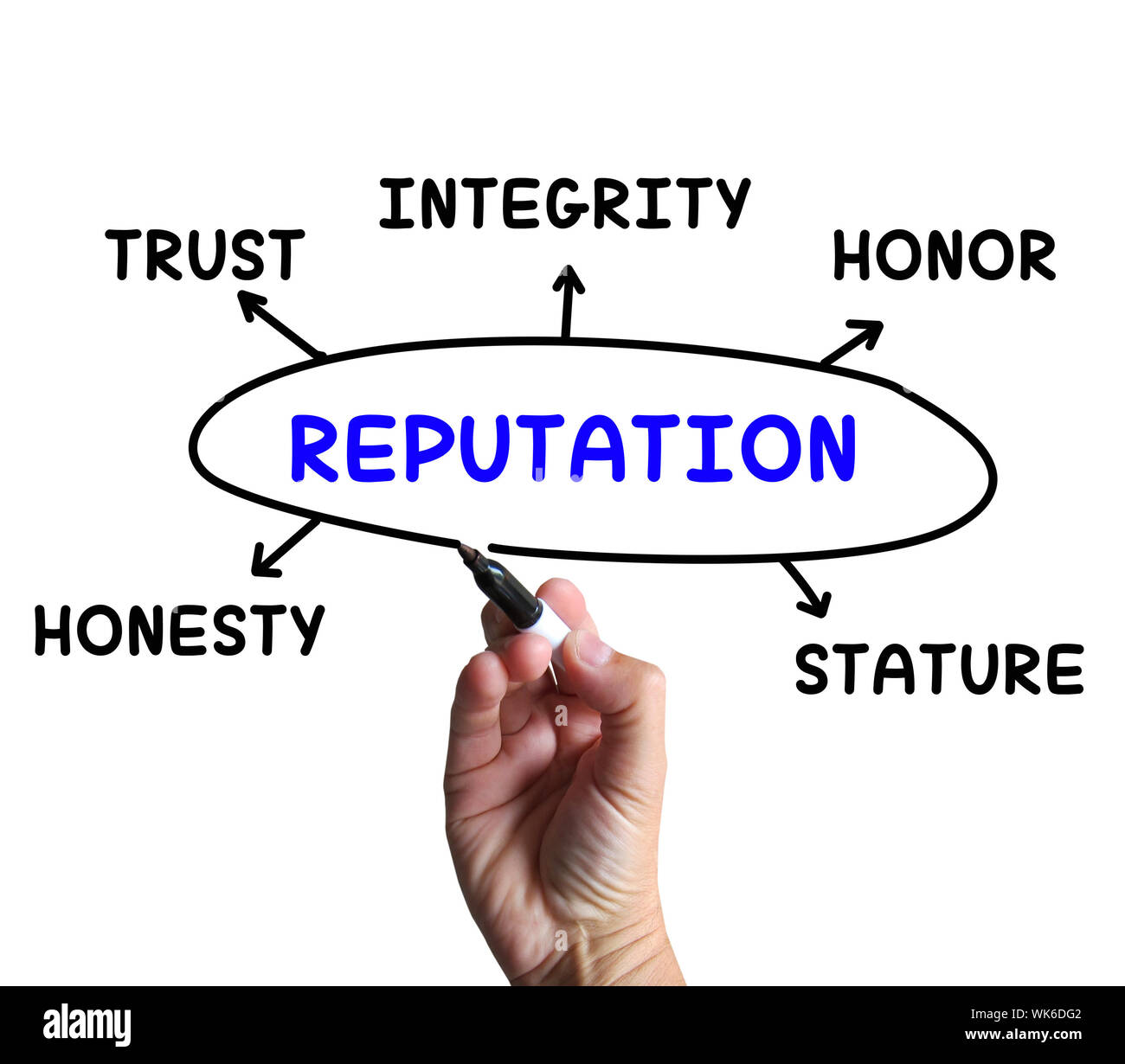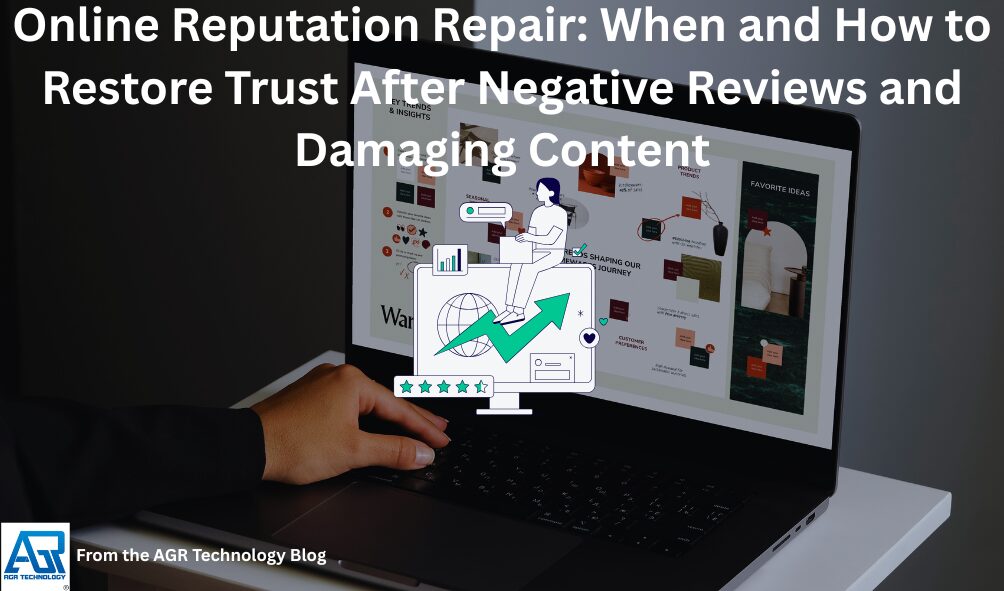In today’s digital world our online reputation can make or break new opportunities. One negative review or damaging post spreads fast and can impact trust before we even realize it. With 90% of consumers reading online reviews before choosing a business it’s clear that perception truly matters.
But when should we take action to repair our online reputation and how do we start? It’s not just about quick fixes—restoring trust takes time strategy and a commitment to authentic communication. By understanding when to intervene and using the right tools and tactics we can turn setbacks into chances for growth and resilience.
Need help protecting your online reputation? Reach out to AGR Technology for a confidential consultation
Understanding Online Reputation Repair

Online reputation repair focuses on restoring a positive digital presence when negative content, reviews or misinformation disrupts brand trust. In today’s online environment, digital reputation drives decisions, relationships and opportunities.
When Is Online Reputation Repair Necessary?
Online reputation repair becomes necessary after negative search results, harsh reviews or damaging social media posts impact trust and credibility. It’s required if:
- Business listings display one-star reviews or critical feedback that affects customer decisions.
- Search engines show outdated, harmful news stories or misleading information.
- Social media profiles attract negative mentions or viral backlash.
- Professional or personal reputations suffer from online defamation or inaccurate content.
Damaged online reputations often lead to lost customers, lost job opportunities and a reduction in brand trust. Quick intervention protects long-term visibility and growth.
Common Causes of Reputation Damage
Common causes of reputation damage include a mix of intentional and unintentional digital events:
- Negative online reviews: Platforms like Google and Facebook host public feedback that heavily influences perception.
- Viral social media posts: Controversial content or critical comments can reach large audiences in hours.
- Search engine results: Outdated articles, inaccurate information or critical news stories may appear at the top of search results.
- Online defamation: False allegations or posts from third parties can quickly circulate.
- Poor review management: Ignoring or mishandling negative customer experiences indicates a lack of care.
- Crisis events: PR issues or operational failures sometimes escalate into wider digital scrutiny.
Effective online reputation services addresses these incidents through content removal, SEO optimization and active review management, helping restore digital presence and rebuild trust.
Assessing the Impact and Root Causes
Assessing the impact and root causes guides our online reputation repair strategy. Evidence-based evaluation ensures we address the right issues and select effective solutions.
How to Identify and Measure Reputation Issues
Identifying and measuring reputation issues starts with systematic monitoring and analysis. We use online reputation management tools to scan reviews, social media conversations, and news mentions for negative sentiment and volume. Search engine results show where negative content ranks, exposing visible threats to digital presence and brand trust. We map how bad reviews and news stories correlate with customer actions like sales drops or reduced engagement, confirming the business impact. Reviewing feedback from stakeholders such as clients and employees helps us spot recurring patterns and verify the severity of reputation problems.
Recognizing the Scope of the Problem
Recognizing the scope of the problem defines our approach. If negativity stays limited to single channels—like Google reviews or one social site—targeted action resolves issues quickly. For reputation damage spread across multiple review sites, news outlets, and social networks, we prioritize a coordinated and sustained response. Ongoing crises, such as repeated complaints or viral criticism, indicate the need for long-term repair and communication strategies. Analysing these vectors, we determine if we’re dealing with isolated incidents or deeper systemic issues affecting overall credibility.
Effective Strategies for Online Reputation Repair
Effective online reputation repair combines timely intervention and strategic actions to restore trust and mitigate the impact of damaging content. Strong digital presence relies on removing harmful material, addressing negative feedback, and generating positive narratives that reinforce credibility.
Removing or Suppressing Negative Content
Removing or suppressing negative content is central to protecting online reputation. We first identify all sources of harmful reviews, news articles, or defamatory posts. Verification follows to confirm accuracy and origin. If false or outdated, we submit removal requests to website administrators, search engines, or platforms hosting the material. If removal isn’t possible, we apply search engine optimization (SEO) techniques to push negative results further down. We create authoritative content and manage high-visibility digital properties like websites, blogs, and key social profiles to outrank negative items. This approach lessens the prominence of damaging content across search results and social channels.
Responding Authentically to Negative Feedback
Responding authentically to negative feedback demonstrates accountability and strengthens brand trust. We monitor all major review sites, social media channels, and online forums for new negative comments. Responses are prompt, transparent, and empathetic. We acknowledge concerns directly and detail corrective actions, avoiding defensive language. Public, constructive engagement transforms criticism into a demonstration of our commitment to improvement. Direct messaging resolves more sensitive issues offline, turning dissatisfied parties into advocates if their problems are resolved satisfactorily. Studies report that 45% of consumers will revisit a business that addresses negative feedback constructively.
Generating and Promoting Positive Content
Generating and promoting positive content supports ongoing trust and counters negative narratives. We highlight achievements through blog posts, customer testimonials, case studies, and news releases. We encourage satisfied clients to leave honest reviews on trusted platforms. Sharing positive milestones and team success stories across social media increases brand sentiment and visibility. Teaming up with professional networks and industry partners extends our reach and positions us as thought leaders in the space. Continuous content creation and promotion, including SEO-aligned articles and media placements, keeps positive digital footprints dominant in search results.
Table: Actions and Outcomes in Online Reputation Repair
| Strategy | Key Actions | Expected Outcome |
|---|---|---|
| Removing/Suppressing Negative Content | Removal requests, SEO suppression, content replacement | Lower visibility of harms |
| Responding Authentically | Transparent replies, resolving issues publicly or privately | Restored trust, improved perception |
| Generating Positive Content | Testimonials, blogs, social campaign, network collaboration | Increased positive digital presence |
Strategic, tailored action underpins effective online reputation repair, protecting personal and business interests in the digital environment.
Tools and Techniques for Monitoring and Management

Effective online reputation repair depends on robust monitoring and timely management. Comprehensive tracking of digital reputation signals and direct customer engagement enable us to detect issues, maintain brand trust, and implement corrective actions rapidly.
Automated Monitoring Solutions
Automated monitoring solutions deliver continuous insight into our online presence by tracking mentions, reviews, and comments across websites and social media. Platforms such as Brand24 and Google Alerts scan digital channels for brand name, product, or key stakeholder references. Social listening tools aggregate sentiment analysis from channels like Twitter, Facebook, and industry forums. These systems push real-time alerts on negative feedback or potential threats, minimising the window for reputational harm.
We rely on automation to:
- Detect emerging negative content within minutes
- Generate sentiment analysis dashboards
- Track review trends over time
- Provide actionable data for prioritised responses
Using automated tools also supports detailed digital footprints by recording review sources, mention frequency, and overall brand sentiment. This enables precise identification of at-risk areas and helps us measure the impact of corrective strategies.
Engaging With Review and Social Platforms
Engaging directly with review and social platforms highlights our responsiveness and commitment to customer satisfaction. We monitor hubs like Google Reviews, Yelp, and TripAdvisor, responding to both positive and negative feedback to foster public brand trust. Addressing negative comments quickly and offering resolutions demonstrates transparency and care, converting dissatisfied users into advocates when possible.
Proactive engagement activities include:
- Responding to customer reviews within 24 hours
- Offering personalised solutions or follow-up when concerns arise
- Sharing updates and achievements via social channels
- Encouraging satisfied customers to post public testimonials
Engagement helps us control narratives around our brand and nudges search algorithms to prioritise positive, recent interactions. Active communication also supports ongoing reputation monitoring by collecting direct feedback and identifying brewing concerns before they escalate.
These monitoring and engagement strategies create the foundation for ongoing online reputation repair, safeguarding our digital presence and supporting continuous brand credibility.
Building a Positive Reputation Post-Repair
Strengthening our digital presence post-repair means sustaining proactive online reputation repair practices and reinforcing the trust we’ve rebuilt. Ongoing action in key areas keeps our brand credible and prepared for future challenges.
Encouraging Customer Advocacy and Reviews
Promoting positive feedback from our audience boosts our digital reputation after we’ve addressed previous concerns. Asking for reviews regularly helps collect fresh testimonials on platforms like Google, Yelp, and TripAdvisor. Streamlining the review process—such as providing links in follow-up emails—makes it easier for satisfied customers to share their experiences. Addressing negative reviews promptly and constructively, like offering resolutions or clarifying misunderstandings, shows we value honest feedback and act on it. Sharing positive reviews through our website and social channels builds social proof and reassures potential customers. Fostering a community of advocates by recognizing loyal supporters—through thank-you notes, loyalty perks, or exclusive previews—encourages them to continue supporting our brand.
Maintaining a Consistent and Transparent Brand Image
Maintaining a transparent, consistent image across all channels fortifies our online reputation repair efforts. Every public statement, social post, or customer interaction must reflect honesty and our commitment to open communication. Using clear, aligned messaging prevents confusion and ensures stakeholders always know what to expect from us. Explaining challenges and sharing updates about improvements—such as service enhancements prompted by customer feedback—demonstrates accountability and authenticity. Regular monitoring across websites, social media, and review platforms lets us identify and address potential discrepancies in tone or information. Keeping our brand voice unified—whether in FAQs, blog posts, or customer service replies—reinforces trust and protects our professional standing.
Key Digital Reputation Metrics Post-Repair
| Metric | Description | Desired Trend |
|---|---|---|
| Review Volume | Number of new customer reviews | Increase |
| Positive Review Ratio | % of 4-5 star reviews | Increase |
| Response Time | Average reply speed to online feedback | Decrease |
| Social Engagement | Audience interaction on posts and updates | Increase |
| Issue Resolution Rate | % of resolved public complaints | Increase |
Ongoing action maintains and enhances our online presence, securing the positive impact of our reputation repair initiatives.
Conclusion
Online reputation repair isn’t just a one-time fix—it’s an ongoing process that demands our attention and adaptability. When we take swift, thoughtful action and leverage the right tools, we can turn setbacks into opportunities for growth.
By staying vigilant and embracing proactive strategies, we protect our digital presence and ensure our brand continues to earn trust. Let’s remember that a strong reputation is built on transparency, accountability, and continuous improvement.
Need help protecting your online reputation? Reach out to AGR Technology for a confidential consultation
Key Takeaways
- Online reputation repair is essential when negative reviews, outdated information, or viral posts threaten personal or business credibility and trust.
- Effective repair strategies involve removing or suppressing harmful content, responding authentically to negative feedback, and generating positive content to rebuild trust.
- Regular monitoring with automated tools and active engagement on review and social platforms help quickly identify, address, and mitigate reputation issues.
- Sustaining a positive digital presence post-repair requires ongoing review management, encouraging customer advocacy, and maintaining clear, transparent brand messaging.
- Consistently tracking digital reputation metrics like review volume, response time, and sentiment ensures long-term credibility and prepares brands for future challenges.
Frequently Asked Questions
Why is online reputation important?
A strong online reputation builds trust with customers, influencing their decisions and willingness to do business. Since 90% of consumers consult online reviews, even a single negative review can seriously damage credibility and impact sales.
When should I consider online reputation repair?
You should consider online reputation repair if you notice negative reviews, damaging search results, viral social media posts, or any content that harms your personal or brand credibility online.
What are common causes of online reputation damage?
Reputation can be damaged by negative reviews, harmful social media posts, outdated or misleading search results, online defamation, poor response to crises, or unmanaged negative feedback.
What are effective strategies to repair a damaged online reputation?
Key strategies include removing or suppressing negative content, using SEO to push down negative results, responding authentically to criticism, and promoting positive content that showcases trustworthiness.
How do I identify the root cause of reputation issues?
Assess where and how negativity appears by monitoring reviews, social media, and news mentions. Analyze feedback and look for recurring patterns to determine the underlying reasons for reputation problems.
How can responding to negative reviews help my reputation?
Responding promptly and sincerely to negative reviews shows accountability, demonstrates a commitment to improvement, and can rebuild trust with customers and the public.
What are the benefits of proactive review management?
Proactively managing reviews helps identify emerging issues, allows you to address concerns quickly, encourages positive feedback, and ensures your brand narrative remains favorable and consistent online.
How do I promote positive content for my brand?
Create and share valuable blog posts, testimonials, and success stories. Encourage satisfied customers to leave positive reviews and engage actively on your social media channels.
What metrics should I monitor after repairing my online reputation?
Track review volume, the ratio of positive to negative reviews, average response times, engagement rates on social media, and issue resolution rates to measure ongoing reputation health.
How can I strengthen my online reputation post-repair?
Maintain transparency, request feedback, regularly update your content, encourage ongoing customer advocacy, and monitor all platforms to prevent future reputation issues.
Related content:
CEO / Corporate Executive Reputation Management
GenAI Reputation Management Solutions
Realestate Reputation Management
Source(s) cited:
Howarth, Josh. “81 Online Review Statistics (New 2024 Data)” 18 May 2022, explodingtopics.com/blog/online-review-stats. Accessed 8 July 2025.
[Online]. Available at: https://c8.alamy.com/comp/WK6DG2/reputation-diagram-meaning-stature-trust-and-credibility-WK6DG2.jpg (Accessed: 8 July 2025).
Bassig, Migs. “Powerful Examples of How to Respond to Negative Reviews.” ReviewTrackers. February 16, 2022. Accessed July 8, 2025. https://www.reviewtrackers.com/guides/examples-responding-reviews/.

Alessio Rigoli is the founder of AGR Technology and got his start working in the IT space originally in Education and then in the private sector helping businesses in various industries. Alessio maintains the blog and is interested in a number of different topics emerging and current such as Digital marketing, Software development, Cryptocurrency/Blockchain, Cyber security, Linux and more.
Alessio Rigoli, AGR Technology
![logo-new-23[1] logo-new-23[1]](https://agrtech.com.au/wp-content/uploads/elementor/thumbs/logo-new-231-qad2sqbr9f0wlvza81xod18hkirbk9apc0elfhpco4.png)
